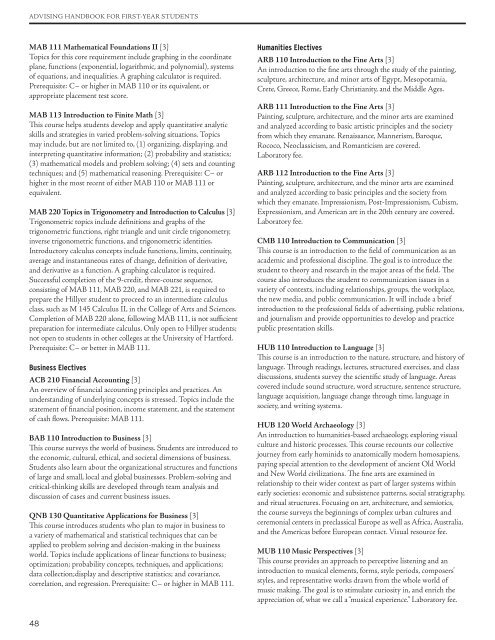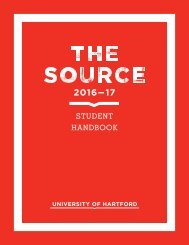advising
You also want an ePaper? Increase the reach of your titles
YUMPU automatically turns print PDFs into web optimized ePapers that Google loves.
ADVISING HANDBOOK FOR FIRST-YEAR STUDENTS<br />
MAB 111 Mathematical Foundations II [3]<br />
Topics for this core requirement include graphing in the coordinate<br />
plane, functions (exponential, logarithmic, and polynomial), systems<br />
of equations, and inequalities. A graphing calculator is required.<br />
Prerequisite: C– or higher in MAB 110 or its equivalent, or<br />
appropriate placement test score.<br />
MAB 113 Introduction to Finite Math [3]<br />
This course helps students develop and apply quantitative analytic<br />
skills and strategies in varied problem-solving situations. Topics<br />
may include, but are not limited to, (1) organizing, displaying, and<br />
interpreting quantitative information; (2) probability and statistics;<br />
(3) mathematical models and problem solving; (4) sets and counting<br />
techniques; and (5) mathematical reasoning. Prerequisite: C– or<br />
higher in the most recent of either MAB 110 or MAB 111 or<br />
equivalent.<br />
MAB 220 Topics in Trigonometry and Introduction to Calculus [3]<br />
Trigonometric topics include definitions and graphs of the<br />
trigonometric functions, right triangle and unit circle trigonometry,<br />
inverse trigonometric functions, and trigonometric identities.<br />
Introductory calculus concepts include functions, limits, continuity,<br />
average and instantaneous rates of change, definition of derivative,<br />
and derivative as a function. A graphing calculator is required.<br />
Successful completion of the 9-credit, three-course sequence,<br />
consisting of MAB 111, MAB 220, and MAB 221, is required to<br />
prepare the Hillyer student to proceed to an intermediate calculus<br />
class, such as M 145 Calculus II, in the College of Arts and Sciences.<br />
Completion of MAB 220 alone, following MAB 111, is not sufficient<br />
preparation for intermediate calculus. Only open to Hillyer students;<br />
not open to students in other colleges at the University of Hartford.<br />
Prerequisite: C– or better in MAB 111.<br />
Business Electives<br />
ACB 210 Financial Accounting [3]<br />
An overview of financial accounting principles and practices. An<br />
understanding of underlying concepts is stressed. Topics include the<br />
statement of financial position, income statement, and the statement<br />
of cash flows. Prerequisite: MAB 111.<br />
BAB 110 Introduction to Business [3]<br />
This course surveys the world of business. Students are introduced to<br />
the economic, cultural, ethical, and societal dimensions of business.<br />
Students also learn about the organizational structures and functions<br />
of large and small, local and global businesses. Problem-solving and<br />
critical-thinking skills are developed through team analysis and<br />
discussion of cases and current business issues.<br />
QNB 130 Quantitative Applications for Business [3]<br />
This course introduces students who plan to major in business to<br />
a variety of mathematical and statistical techniques that can be<br />
applied to problem solving and decision-making in the business<br />
world. Topics include applications of linear functions to business;<br />
optimization; probability concepts, techniques, and applications;<br />
data collection;display and descriptive statistics; and covariance,<br />
correlation, and regression. Prerequisite: C– or higher in MAB 111.<br />
Humanities Electives<br />
ARB 110 Introduction to the Fine Arts [3]<br />
An introduction to the fine arts through the study of the painting,<br />
sculpture, architecture, and minor arts of Egypt, Mesopotamia,<br />
Crete, Greece, Rome, Early Christianity, and the Middle Ages.<br />
ARB 111 Introduction to the Fine Arts [3]<br />
Painting, sculpture, architecture, and the minor arts are examined<br />
and analyzed according to basic artistic principles and the society<br />
from which they emanate. Renaissance, Mannerism, Baroque,<br />
Rococo, Neoclassicism, and Romanticism are covered.<br />
Laboratory fee.<br />
ARB 112 Introduction to the Fine Arts [3]<br />
Painting, sculpture, architecture, and the minor arts are examined<br />
and analyzed according to basic principles and the society from<br />
which they emanate. Impressionism, Post-Impressionism, Cubism,<br />
Expressionism, and American art in the 20th century are covered.<br />
Laboratory fee.<br />
CMB 110 Introduction to Communication [3]<br />
This course is an introduction to the field of communication as an<br />
academic and professional discipline. The goal is to introduce the<br />
student to theory and research in the major areas of the field. The<br />
course also introduces the student to communication issues in a<br />
variety of contexts, including relationships, groups, the workplace,<br />
the new media, and public communication. It will include a brief<br />
introduction to the professional fields of advertising, public relations,<br />
and journalism and provide opportunities to develop and practice<br />
public presentation skills.<br />
HUB 110 Introduction to Language [3]<br />
This course is an introduction to the nature, structure, and history of<br />
language. Through readings, lectures, structured exercises, and class<br />
discussions, students survey the scientific study of language. Areas<br />
covered include sound structure, word structure, sentence structure,<br />
language acquisition, language change through time, language in<br />
society, and writing systems.<br />
HUB 120 World Archaeology [3]<br />
An introduction to humanities-based archaeology, exploring visual<br />
culture and historic processes. This course recounts our collective<br />
journey from early hominids to anatomically modern homosapiens,<br />
paying special attention to the development of ancient Old World<br />
and New World civilizations. The fine arts are examined in<br />
relationship to their wider context as part of larger systems within<br />
early societies: economic and subsistence patterns, social stratigraphy,<br />
and ritual structures. Focusing on art, architecture, and semiotics,<br />
the course surveys the beginnings of complex urban cultures and<br />
ceremonial centers in preclassical Europe as well as Africa, Australia,<br />
and the Americas before European contact. Visual resource fee.<br />
MUB 110 Music Perspectives [3]<br />
This course provides an approach to perceptive listening and an<br />
introduction to musical elements, forms, style periods, composers’<br />
styles, and representative works drawn from the whole world of<br />
music making. The goal is to stimulate curiosity in, and enrich the<br />
appreciation of, what we call a “musical experience.” Laboratory fee.<br />
48



